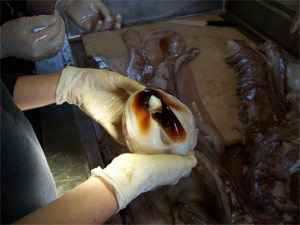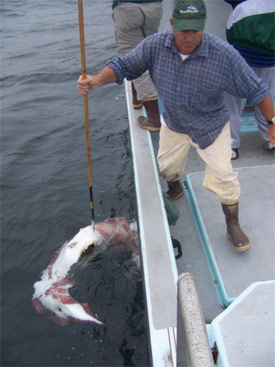
FACTS
- Stomach samples taken from sperm whales indicate that Architeuthis dux is preyed upon by these large cetaceans
- Giant squid have the largest eyes in the animal kingdom, measuring up to 25 centimeters in diameter
- Scientists estimate that giant squid are short-lived and grow extremely fast, growing from a few centimeters in length to full sized in about 5 years (Smithsonian Institution, 1999)
On June 24th, 2008, researchers from the Pelagic Shark Research Foundation (PSRF) recovered the floating carcass of a giant squid (Architeuthis dux) about 12 nautical miles off Santa Cruz, over the Monterey Submarine Canyon, in waters 1,280 meters deep. Expedition leader Sean Van Sommeran spotted and identified the drifting giant squid, and together with Callaghan Fritz-Cope and crew recovered it aboard the vessel Mavrix. Van Sommeran reported the discovery to Dr. Guy Oliver of the University of California Santa Cruz (UCSC).

Squid experts from UCSC, National Marine Fisheries Service, Hopkins Marine Station, and others performed a necropsy, measured the animal, and collected samples for further study. The 5 meter long carcass was missing two-thirds of its tentacles and organs due to scavenging, including a large bite out of its mantle. Scientists estimated the intact specimen to have been 6 to 7 meters in total length and more than 100 kg in weight. Although the exact age of the specimen was undetermined, it is likely to be a sub-adult. Following the initial investigation, the body was frozen and transported to the Santa Barbara Museum of Natural history to be preserved and archived.
Scientists are still seeking to understand the biology and life history of Architeuthis dux, as they are not often seen alive and nearly impossible to rear in captivity. However, it is believed that they can grow up to 18 meters in length and reach nearly a ton in weight, making them the largest invertebrates on earth (Feldman, 2008). It has been determined from stomach samples that giant squids are piscivorous (meaning that they feed on fish), though their hunting behavior is still a matter of debate. Carcasses have been found in the Pacific, Atlantic, and Indian Oceans. According to the Smithsonian Institute, this is the third specimen found in Monterey Bay, the first being found in 1911 and the second in 1912 (Berry, 1914). This most recent specimen is the largest most complete specimen ever recovered from Monterey Bay, and one of only a few ever collected from the Eastern Pacific Ocean.

|